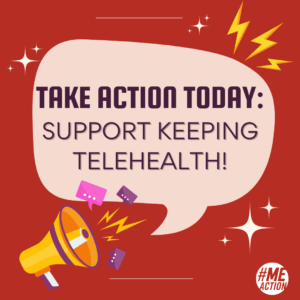INTRODUCTION
The Centers for Disease Control (CDC) is revising and creating new educational materials for its Myalgic Encephalomyelitis/Chronic Fatigue Syndrome (ME/CFS) educational program. The hope is that this fourth try at producing ME/CFS educational materials will result in equality of care for ME/CFS patients and they will, for the first time, experience appropriate care throughout the gamut of our healthcare system: from primary care provider to subspecialty care. According to the CDC, the revisions will reflect the content and recommendations of the 2015 Institute of Medicine (IOM) ME/CFS report.1 That report found the name, Chronic Fatigue Syndrome, stigmatizing to the illness. Comments expressing that sentiment occur throughout the document. Thus, the view of the IOM’s ME/CFS Authoring Committee is that the illness currently known as ME/CFS has been stigmatized. That stigma affects healthcare delivery and, in consequence, patient quality of life.
To fulfil the CDC’s mission of improving the healthcare provided to ME/CFS patients and thereby improving patients’ quality of life, the CDC should go beyond the information contained in the IOM ME/CFS report. More recent, relevant documents and information, as well as the advice gleaned from professional healthcare educators warrant consideration. Specifically, the information and recommendations contained in the National Research Council and Institute of Medicine jointly sponsored report on stigmatized illnesses2 should be included. The information and recommendations contained in that report are consistent with and even an extension of the IOM’s ME/CFS report.
The CDC’s ME/CFS educational program revision seems focused solely on the revision of its educational material. The CDC has not indicated a willingness to consider alterations in the methodology it will use to deliver its revised information or changes in personnel who will convey it. Experienced healthcare educators know that educational content is but part of a successful transmission of information from expert to student. The packaging of the message, the mechanism of its delivery, as well as who delivers it are as important, if not more important, than the content of the message itself. For the message to be received, its relevance to the recipient needs to be manifest, and its importance to the recipient apparent. These considerations are recommended in the NRC/IOM Stigmatized Illness Report.
The CDC’s Stated Revision Process
According to the CDC, the process by which the new ME/CFS educational materials will be produced involves holding a technical development workshop at which participants will, “help identify needs and priority topics for ME/CFS information and educational materials…We would like to invite your organization to participate in this collaboration by nominating a representative to serve as a member of the Technical Development Workgroup (TDW). …The process for designing these materials must be a transparent collaboration that involves healthcare professionals, patients and advocates, medical educational organizations, and federal agencies”3
Concerns with the CDC’s Stated Revision Process
The purpose of the CDC’s ME/CFS educational material revision is stated in a one-page overview sent to invitees of the Technical Development Workshop: “The purpose of this project is to update the Centers for Disease Control and Prevention’s educational materials and web content on ME/CFS, informed by the IOM report’s findings and recommendations and the perspectives of patients, providers, researchers and federal partners.”
- While the original intent of this project might have been to incorporate the latest ME/CFS findings from an authoritative source, the stated purpose of this project prevents consideration of newer, relevant material that has been published subsequently to the announcement date.
- The CDC announcement makes no mention of seeking the opinion of experienced healthcare educators whose advice would be similar to the recommendations contained in the NRC/IOM Stigmatized Illness Report which has yet to earn inclusion in the CDC’s ME/CFS knowledge base.
- The one-page project overview indicates that the intent of the CDC is to develop one set of educational materials which will be shared among, “a variety of audiences.” The strategy of developing one set of educational materials to be shared among audiences holding different perspectives is at odds with the recommendations of the NRC/IOM Stigmatized Illness Report. The latter suggests educational materials be tailored to the specific backgrounds and interests of each, specific, target audience; be delivered in a manner that sustains their particular interests; and be presented by personnel who command the respect of each, specific target audience.
- Limiting the knowledge base to the IOM’s ME/CFS report excludes considering the reasons why the CDC’s previous, three ME/CFS educational programs did not achieve their goals of increasing healthcare coverage for ME/CFS patients. Since 2003, the CDC has launched three ME/CFS educational programs: the Trained Trainer Program4, the Spark Awareness Campaign5 and several continuing medical education courses delivered via the internet.6 A recent study,7 as well as the IOM ME/CFS report itself, reveal that these efforts have had little impact on ME/CFS patient access to care, or referral to specialized care. The 2014 survey7 gathered data from 998 patients throughout the U.S.A. Patient dissatisfaction with medical care was rated high in comparison to a control group. Multiple census regions within the United States were identified which lacked patient accessibility to any specialized care.
It is, therefore, unlikely that wordsmithing and prioritizing ME/CFS materials contained in the IOM’s ME/CFS report, and distributing that revised material without altering the methodologies of distribution, will result in increased access to medical care or increased quality of medical care for ME/CFS patients.
ME/CFS Satisfies the NRC/IOM Criteria of A Stigmatized Illness
The CDC should consider ME/CFS a stigmatized illness because ME/CFS satisfies the definition of a stigmatized illness as defined by the National Research Council/Institute of Medicine Ad Hoc Committee’s Report on Stigmatized Illnesses.2 The Report defines a stigmatized illness as, “any condition with no known cause or cure.” Cited examples of such illnesses and/or conditions are: cleft palate, epilepsy, tuberculosis, cancer, and HIV/AIDS. The Report observes that, “When cause of illness becomes known, or when a cure is developed, the stigma associated with the condition wanes.”8
Economic Justification For Treating ME/CFS As A Stigmatized Illness
While the NRC/IOM Stigmatized Illness Report acknowledges additional expenses are incurred in educational programs that include activities aimed at reducing or eliminating the stigma associated with illnesses, the authors of this report maintain that the reduction in healthcare costs generated by improved health of patients, and the return of those patients to more productive lifestyles, more than offset the costs of including stigma-reducing activities in educational programming.
Brief History of ME/CFS As A Stigmatized Illness
In 1955, an outbreak of ME/CFS was characterized as, “mass hysteria.”9 A 1987 article appearing in the New York Times10 quotes one, “expert,” as characterizing the illness as, “Yuppie Flu,” despite data and expert opinion to the contrary being offered in the same article. That stigmatization persists in recent times as evidenced by: (1) a survey published in 2014, conducted by Dr. Don Baken, a clinical psychologist at the School of Psychology at Massey University in New Zealand who found ME/CFS patients feel misunderstood and stigmatized,11 and (2) the announcement on September 10th of this year, that a panel of, “experts,” for the Canadian Institute of Health Research rejected funding of all proposed ME/CFS research because, “there is no evidence that Chronic Fatigue Syndrome is a disease.” Rather, evidence suggests that, “psychosocial factors,” are, “both a cause and perpetuating factor for CFS.”12 Perhaps The Guardian’s recently published review of the medical world’s treatment of ME/CFS best summarizes contemporary management of ME/CFS: “Yet for much of the past three decades, CFS has been treated as the proverbial skeleton in the closet of the medical world. Potential researchers have been scared off by the stigma associated with the disease, and government funding has been nonexistent. “When I was a medical student in the 90s, we were instructed that CFS patients could not be seen in our clinic,” Montoya recalls. “And a letter was sent out to those patients telling them not to come.” 13
To account for the etiology of such stigmatization, Richman, et al.14 propose that the failure of Western medicine to demonstrate a viral etiology of ME/CFS has led to healthcare practitioners embracing psychiatric and sociocultural explanations of the illness thereby delegitimizing ME/CFS as a biomedical phenomenon.
The Application of Destigmatization Science to ME/CFS Educational Programs
Destigmatization science is relatively new. “Stigmatized illness,” is not a Medical Subject Heading (MeSH Term) in the National Library of Medicine’s thesaurus of controlled vocabulary used to index articles for MEDLINE although it is currently being considered.15 Searching the MEDLINE database using, “Stigmatized Illness,” as an, “other,” term yields 270 papers in the database containing that term, with the earliest paper having been published in 1985. Searching MEDLINE using the terms, “Chronic Fatigue Syndrome,” and, “Stigmatized Illness,” yields just 2 articles: one dated 2002, the other dated 2008. Hence the consideration of ME/CFS as a stigmatized illness is a relatively recent development.
In mounting an ME/CFS educational program for healthcare providers and/or the general public, the NRC/IOM Report on Stigmatized Illnesses would recommend the inclusion of the elements listed in Table 1 below. For the purpose of providing possible explanations as to why the previous CDC ME/CFS educational programs did not achieve their desired outcomes, the utilization of the stigma-reducing elements by each of the CDC’s previous three programs is shown in columns on the right-hand side of Table 1.

Table Legend: The column marked, “TtTP,” contains the scores for the Train the Trainer Program. The column marked, “Spark,” contains the scores for the Spark Awareness Campaign. The column marked, “Online,” scores the results for the online medical education courses. “?” indicates doubt as to whether the program utilized that element. Scoring is the personal opinion of the author based upon knowledge and experience with the programs.
Summary
The three previous CDC educational programming efforts designed to increase healthcare provider knowledge about ME/CFS and increase healthcare provider participation in the improvement of healthcare delivered to ME/CFS patients were not designed to be, nor knowingly included, illness destigmatizing elements. Perhaps the lack of recognition of ME/CFS as a stigmatized illness in these programs, and the lack of stigma-reducing content in these programs contributed to their less than anticipated outcomes. Table 1 lists 16 elements which should be included in the design and implementation of a successful illness-destigmatizing, educational program. The Train-the-Trainer Program lacked 8 of these elements, the Spark Awareness Campaign lacked 10, and the online medical education programs lack 8. Other stigma-reducing elements which these programs may or may not have included are indicated by “?” in the Table. Most likely, each of these programs contained approximately one-half of the suggested stigma-reducing elements which may account for the unanticipated, disappointing outcomes of these programs. Because ME/CFS should now be recognized as a stigmatized illness, educational programming going forward should be designed to include stigmareducing elements to overcome false beliefs regarding the illness and encourage healthcare providers to provide appropriate care regardless of level: from primary care to subspecialty care.
A final note: It is possible to design an illness-destigmatizing program that fails, despite the incorporation of the 16 elements listed above. According to the NRC/IOM Report, stigma-reducing programs fail for three reasons:
- The message design was not driven by testing.
- The message focused on personal consequences but not relevant ones.
- The argument that was crafted did not fit the desired program outcome.
Thus, the factual or scientific content of an illness-destigmatizing program is not what determines its success or failure. It is the presence or absence of ongoing evaluation, providing programming that is relevant to each specific target audience, and the crafting of the programming so that it compels the desired outcome. None of the destigmatizing illness elements have been considered in the IOM’s ME/CFS report. Hence, to rely solely on that report as the knowledge base for the revised ME/CFS educational program risks another disappointing outcome.
References:
- Beyond Myalgic Encephalomyelitis/ Chronic Fatigue Syndrome: Redefining an Illness.
- Ending Discrimination Against People with Mental and Substance Use Disorders: The Evidence for Stigma Change. Committee on the Science of Changing Behavior Health Social Norms; Board on Behavioral, Cognitive and Sensory Sciences; Division of Behavioral and Social Sciences and Education; National Academies of Sciences, Engineering, and Medicine, The National Academies Press, Washington, D.C., nap.edu, 2016
- Unger, E. (December 17, 2015) Email entitled, “Invitation to Participate on ME/CFS Technical Development Workgroup”
- Brimmer, D.J., McCleary, K.K., Lupton, T.A., Faryna, K.M., Hynes, K., and Reeves, W.C. (2008). A train-the-trainer education and promotion program: chronic fatigue syndrome—a diagnostic and management challenge. BMC Medical Education (2008) 8:49
- http://www.hhs.gov/advcomcfs/meetings/presentations/buildingcrediblemomentum.pdf; http://www.cbsnews.com/news/is–chronic–fatigue–syndrome–real/ (Accessed September 19, 2016)
- http://www.hhs.gov/advcomcfs/meetings/presentations/cdccfsacreportoctober2012.pdf (Accessed September 19, 2016)
- Nicholson, L., Sunnquist, M., Ohanian, D., Brown, A., & Jason, L. A. (2015, May). Addressing utilization and quality of healthcare for ME and CFS patients. Poster presented at the meeting of the Midwestern Psychological Association, Chicago, IL.
- cit. Grob, G.N. (1991) From Asylum to Community. Princeton University Press. Princeton, NJ 9. McEvedy C, Beard A. Royal Free epidemic of 1955: a reconsideration. British Medical Journal. 1970; 1: 7-11.
- New York Times, July 28, 1987
- https://www.massey.ac.nz/massey/about–massey/news/article.cfm?mnarticle_uuid=8689D1E6DD19–C2AD–390E–FC170EEF02. Accessed September 14, 2016
- http://www.ctvnews.ca/health/stigmatized–chronic–fatigue–syndrome–sufferers–seekrecognition–3067130 Accessed September 14, 2016
- http://www.theguardian.com/lifeandstyle/2016/apr/04/chronic–fatigue–syndromecfs–takenseriously
- Richman, J.A., Jason, L.A., Taylor, R.R., Jahn, S.C. [2000] Feminist Perspectives on the Social Construction of Chronic Fatigue Syndrome, Healthcare for Women International, 21:173-185.
- Personal communication via email August 26, 2016.
- Derived from the content of citation #2 listed above.
- cit. Papish, A., Kassam, A., Modgill, G., Vaz, G. Zanussi, L., and Patten, S. (2013) Reducing the stigma of mental illness in undergraduate medical education: A randomized, controlled trial. BMC Medical Education 13(1):143.
Save
Save
Save
Save
Save






4 thoughts on “Increasing Efficacy of the CDC’s ME/CFS Educational Program”
As I understand this, the CDC is making it look like it’s doing something good for ME patients and health care providers but putting lipstick on a dying pig instead. My own research has shown medical schools and medical textbook publishers often look to the CDC for content. We don’t need another generation of health care providers with missing or inaccurate knowledge of ME. Thanks, Kenneth, for making us aware. What can we do to make an effective rewrite of ME education programs happen?
Good essay but need to check history – article places McEvedy & Beard articles claiming ME was mass hysteria in 1955, not 1970 & 1971. Then the authors placed the articles in footnote 8, where they should be in 9. Only things I had time to check; there may be others. Cites NYT in fn 9 – the original articles are better citations.
Important to get chronology straight. ME (earlier called atypical polio or Icelandic Disease) outbreaks of mid-1950s were where the disease was renamed ME, since polio was supposed conquered by the vaccine). In 1969 it was recognized by WHO and classified under neurological conditions. That makes the timing of the McEvedy and Beard articles claiming “mass hysteria” (on the basis that two of the outbreaks occurred in women’s dorms) even more meaningful, since it went directly against WHO’s recognition and classification of the disease. The battle between a neurological v. psychiatric view of the disease continues to this day – made worse because neurologists in the UK pretty much abandoned the field to psychiatrists.
This is a joke? “Stigmatized illness” examples are “cleft palate, epilepsy, tuberculosis, cancer, and HIV/AIDS.” Don’t have a known cause? “The Report defines a stigmatized illness as, “any condition with no known cause or cure.””
Maybe stigmatized a long time ago, but these are NOT relevant examples.
Alicia,
The book the author cites here includes the history of stigma. Note that the next line states that once an illness can be ‘proved’ to be embodied, the stigma wanes, showing that inability to understand these illnesses as ‘real’ no longer exists in a rational society… but despite that, traces of that original stigma linger (the stigma ‘wanes’ rather than disappears). It’s discussing both the past and the future in that quotation. The book was released in 2016, but discusses issues of both modern and historical relevance.
I will leave the rest to the original author to discuss. 🙂
-J
Comments are closed.